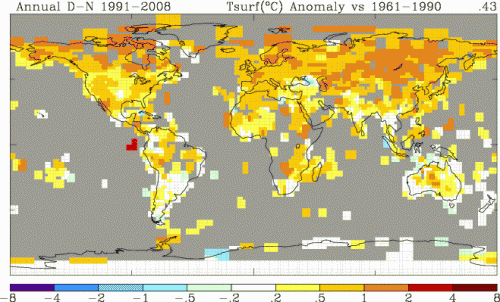Apropos of my last post, Bob Tisdale is beginning a series analyzing the differences between the warmest surface-based temperature set (GISTEMP) and a leading satellite measurement series (UAH). As I mentioned, these two sets have been diverging for years. I estimated the divergence at around 0.1C per decade (this is a big number, as it is about equal to the measured warming rate in the second half of the 20th century and about half the IPCC predicted warming for the next century). Tisdale does the math a little more precisely, and gets the divergence at only 0.035C per decade. This is lower than I would have expected and seems to be driven a lot by the GISS’s under-estimation of the 1998 spike vs. UAH. I got the higher number with a different approach, by putting the two anamolies on the same basis using 1979-1985 averages and then comparing recent values.
Here are the differences in trendline by area of the world (he covers the whole world by grouping ocean areas with nearby continents). GISS trend minus UAH trend, degrees C per decade:
Arctic: 0.134
North America: -0.026
South America: -0.013
Europe: 0.05
Africa: 0.104
Asia: 0.077
Australia: -0.02
Antarctica: 0.139
So, the three highest differences, each about an order of magnitude higher than differences in other areas, are in 1. Antarctica; 2. Arctic; and 3. Africa. What do these three have in common?
Well, what the have most in common is the fact that these are also the three areas of the world with the poorest surface temperature coverage. Here is the GISS coverage showing color only in areas where they have a thermometer record within a 250km box:
The worst coverage is obviously in the Arctic, Antarctica and then Africa. Coincidence?
Those who want to argue that the surface temperature record should be used in preference to that of satellites need to explain why the three areas in which the two diverge the most are the three areas with the worst surface temperature data coverage. This seems to argue that flaws in the surface temperature record drive the differences between surface and satellite, and not the other way around.
Apologies to Tisdale if this is where he was going in his next post in the series.

